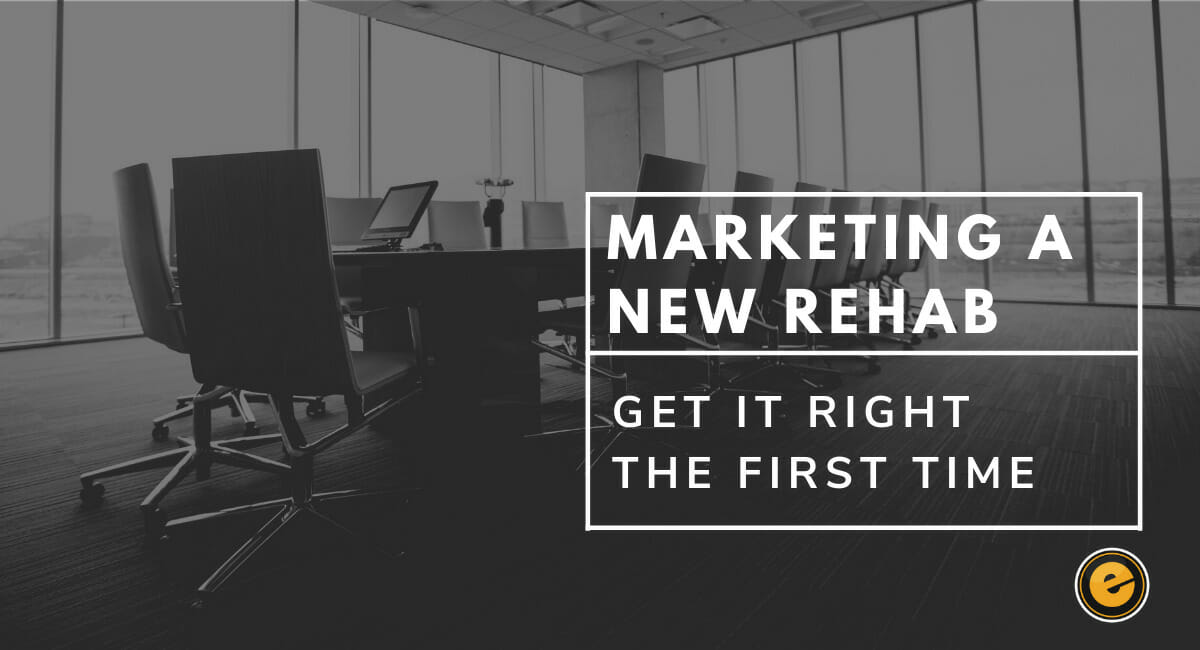
In this post you’ll learn how to market a new addiction rehab- the right way.
Drug and alcohol addiction all too often come with relapse. In the interest of helping those overcome chemical dependency, the businesses meant to support these endeavors are better served with a relapse-free approach to engage successful rehab businesses. For the most well-intended investors and would-be owners, we wanted to share our thoughts on how to bring a new addiction rehab to market right the first time, before you invest hard earned (or borrowed) dollars, time and heartache. Yes, it is a labor of love.
Even if you’ve already vested in a drug or alcohol detox, inpatient residential, PHP, outpatient or sober living facility, the information noted below will offer an opportunity to compare your current practices with what could be improved upon. In addition, this can be the backbone of growth initiatives and potential industry partnerships.
When Marketing a Rehab Know What’s Feasible, Then Find What’s Missing
Every business begins with a single perception about what the specific industry will bear. Meaning, someone has an idea about what type of business is needed and, in turn, what will succeed. While success can be measured in a myriad of ways, the only one that matters from the get-go is what will bring in the money.
Whether you are the owner of a potential treatment recovery enterprise or a silent partner, your thoughts on what will be a success are to some extent, subjective, opinion. Making a financial decision on ego alone (opinion) is risky. Coupling opinion with measurable fact is golden. How do you get to this sweet spot?
It begins by doing a feasibility study, or two or three. This practice isn’t exclusive to the drug rehab industry. It’s used by global advertising agencies before launching new products or services on behalf of their clients. These can be conducted on a localized level as well by small businesses that intend to serve specific geographic areas.
Discovering what addiction treatment needs are specific to an area of town are vital to determining:
- Placement of facility
- Size of facility
- Specific focus of treatment offerings
- Specific target audience (demo- and psychographics)
- Pricing of services
- Duration of service offerings
- Ratio of direct competitors within the area
Feasibility studies involve a Q&A from people who live within the area of interest. These people may be a cross-section of consumers who have either been to treatment before, who have a family member who has been to treatment, or knows of someone who should go to treatment.
With the rates of addiction in the U.S. ($35 billion industry) and the corresponding rates of relapse (50% – 90%, depending on the drug and length of stay in rehab) more people can fulfill the criteria for feasibility study participants than before.
Results tabulated from study participants may not provide you the justification needed in going forward with what you had in mind for your rehab business, but they will offer the low-hanging fruit of opportunity you would otherwise have missed. Perhaps you wanted to focus on alcohol detox and providing medication-assisted treatment such as Suboxone or Gabapentin but through the research, realize that finding detox facilities in the area isn’t the shortfall but adequate sober living facilities is the current need. Perhaps then, a shift in how you start up would be in order.
Under Funding a New Rehabs’ Marketing Budget Can Kill the Best Idea
Once you know the area(s) you will focus the rehab business on, now it’s time to assess the financial needs to fulfill the obligation. If you are not self-funded or the recent recipient of a winning lottery ticket, chances are you’ll be seeking the assistance of investors.
It is best to use the services of an addiction treatment consultant who has vast experience in this space and can provide a knowledgeable overview of what will be needed in capital to get things off the ground and running smoothly for the first three years.
Much of what will attract an investor to your business will be the projected rate of return, net operating income, operating expenses and the total cost of the investment. While these numbers will fluctuate to some degree and the business model becomes more refined over time, investors will be the life blood that keeps your addiction treatment company dream alive.
Emotions Are for Patients, Not Profit
Here is a quick mention about getting into business with friends. Emotions and unspoken expectations will get in the way of effective business planning and successful execution. Profitability is everything in having the ability to provide the best patient care. Sometimes, friendships on the backside of business can put a dent in the process. As long as the financials make sense, doing business with friends and family can work though it is more often than not, inadvisable.
Plan for Scalability
There is beauty in not biting off more than you can chew. Dream big but start small. If you want to have multiple service offerings, scale up. Start with outpatient, then, add a 6-10 bed inpatient residential facility. Then add another one once the others are showing consistent intakes and minimal vacancy time. Down the road, if you want to rework your offerings or add detox while removing outpatient, for example, you only have to worry about downtime in one or two buildings rather than having to go ‘offline’ completely. Options are good and they happen through healthy, sustainable expansion.
Choose Treatment Staff As If They Are Your Trusted Advocates
Though every business takes time to consider their overall mission and vision for existence, bringing the right people to the table may not always be given the thought it deserves. After all, the people who comprise of your clinical, holistic and administrative staff are the face of your business, literally.
Clients, patients, residents, however you refer to the people who receive treatment from your facility, have heightened sensitivity – it’s a byproduct of addiction. As such, those who are their designated caregivers will be the purveyors of your products, brand messengers and creators of your reputation. How they intertwine builds your company culture. It’s best to get a handle on who you are early on so that the tone and manner of the employees mirror how you’d like others to perceive your business. This is important because the addiction treatment industry is a small network of operators and vendors. Any ill-talk about your business will travel fast and will affect your intakes, marketing abilities, staffing, referral business and investment opportunities.
Fixed Vs. Fluid Business and Marketing Plans for Your Treatment Center
The drug and alcohol treatment business casts a wide net of potential: both in prospects and pitfalls. To create or facilitate tight business and marketing plans takes facts, figures, industry know-how and a dash of flexibility. Why? Because the more things stay the same, the more they change.
For example, current government administrators can change the way they allow for drug treatment, alter the classification or what insurance companies will provide. In addition, new laws can affect the likelihood of one drug being the next epidemic versus another. Even the state-to-state definition of what is legal marijuana use continues to change, bringing the potential for shifts in drug use trends and corresponding overuse and addiction.
New regulations will change the way an addiction rehab business will identify opportunities. Staying on top of industry news is a necessity to keeping the market position your rehab has and finding new angles to own more.
Top 10 Considerations Before Starting or Investing in Drug Rehab
The day you open your doors isn’t the end game in starting a new drug or alcohol rehab treatment center. There is no end game. Just like addiction, it’s a never-ending cycle that has its ups, downs and moments of triumph. To get through it all and feel good about what you’re doing, refer to the following checklist during each facet of your rehab business build out.
Top 10 Must Dos Before You Open a New Drug Rehab
- Identify your market niche
- Confirm source of funding
- Target geographic area with numbers that justify location and amount of beds
- Comprise business plan (1, 3 and 5 year forecasts)
- Comprise marketing plan and budgets (launch, 1 and 3 year plans)
- Obtain necessary licensure(s) and be HIPAA compliant
- Partner with local industry leaders
- Bring the best in staff
- Stay on top of news/industry trends
- Remain vigilant and flexible
Marketing Addiction Rehab Businesses Is Different than an Online Retail Store
With the recent onslaught of ‘bad actors’ in the drug addiction treatment and recovery industry, marketing guidelines have taken a harsher turn in what is acceptable and allowable. Google, Facebook and other social outlets have come down hard on facilities, demanding a more thoughtful and accountable approach to the search-and-discover of reliable treatment facilities.
While this presents additional hoops and added costs to advertising platforms within the industry, it also resets the bar on best practices which rehab owners and patients can benefit from. With third party LegitScript certifications required by Google and Facebook, for example, call centers and lead aggregators can’t simply buy ads. Now, if anyone wants to buy Google or even Facebook ads, they must undergo this full certification process… and call centers don’t even qualify.
Before You Start a New Drug Rehab, Open Our Door First






